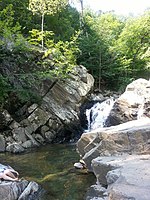American Legion Memorial Bridge (Potomac River)

The American Legion Memorial Bridge, also known as the American Legion Bridge and formerly as the Cabin John Bridge, is a bridge carrying Interstate 495 (Capital Beltway) across the Potomac River between Montgomery County, Maryland and Fairfax County, Virginia in the United States. It is an American Water Landmark. Plummers Island is located immediately downstream of the bridge. The bridge has five traffic lanes in each direction. The outermost lane in each direction is an entrance/exit-only lane for traffic to/from the Clara Barton Parkway in Maryland and the George Washington Memorial Parkway and Georgetown Pike (State Route 193) in Virginia. There are no facilities for pedestrians or cyclists, which are prohibited.
Excerpt from the Wikipedia article American Legion Memorial Bridge (Potomac River) (License: CC BY-SA 3.0, Authors, Images).American Legion Memorial Bridge (Potomac River)
Capital Beltway,
Geographical coordinates (GPS) Address External links Nearby Places Show on map
Geographical coordinates (GPS)
| Latitude | Longitude |
|---|---|
| N 38.97017 ° | E -77.17962 ° |
Address
American Legion Bridge (American Legion Bridge)
Capital Beltway
20818 , Cabin John
Maryland, United States
Open on Google Maps







